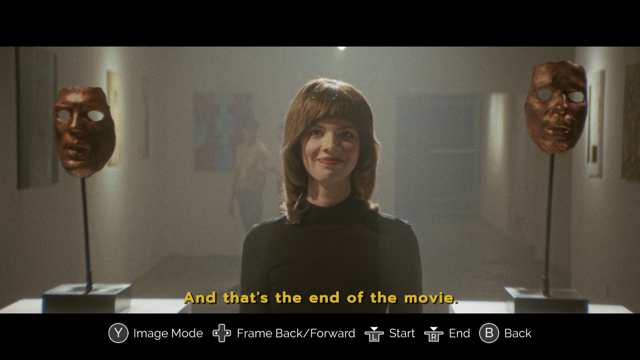ALLTheDinos' Review of Immortality (Full Spoilers)

Author’s Note: Because of the uniqueness (and mechanical lightness) of Immortality’s gameplay, I’m scoring it into two separate sections: the “actual play” aspects of Immortality, and its narrative. For the former category, the scoring range is 1-3 stars (where 3 indicates consistently fun and engaging interactivity). For the narrative, the range is 0-2 stars (essentially, whether it landed for me and/or whether it was intriguing, even in failure).
Oh and if you’re interested in playing this but want to avoid spoilers, I highly recommend stopping after the first paragraph of Part One below. If you want my spoiler-free review, it’s that the game is worth playing on Game Pass but I wouldn’t pay for it otherwise. I played for approximately 6 hours and rolled credits.

Part One: The Game Itself
As you start the game, the presentation shifts to a large quantity of video thumbnails. A tutorial walks you through the primary mechanics of the game, which are: clip selection, playing / pausing, fast forwarding / rewinding, and jumping to the start or end of the selected clip. The more complex mechanic is the object recognition feature ("Image Mode"), which you use during a paused clip to discover more scenes or find links between two scenes you’ve already discovered. The lion’s share of my first hour with the game was spent watching scenes, then rewinding and zooming in on objects of interest to unlock more reels. I’ll dive more into the content of those reels in Part Two of this review, but this is what I would identify as the central gameplay loop. One disappointing aspect of Image Mode was that it felt very scattershot on efficacy. There were moments that I clicked on a specific object I had in mind, like a telephone, and it matched with a window in another scene. It was also pretty easy to get stuck in a recursive loop and not be all that sure where to go next, but this could be resolved by just going somewhere else and clicking like crazy. It’s a very interesting feature, but I’m not sure it was implemented to its full potential in Immortality.
(Major spoilers ahead)
The game shines most where it reveals the true use for the playback controls mechanic. There are (mostly) brief segments of some clips where the game gives you a tell that something else is afoot. If you play with a controller, it begins to vibrate. If not, there’s also a low note that plays during otherwise normal-looking scenes. If you rewind at this time (or after it back to the end of the rumbling / tone), you see something else entirely. In many cases, there’s an overlay of a mysterious figure doing any number of activities. In some scenes, you begin to experience a clip that moves forward and acts independently of anything else you’ve watched thus far. These fourth-wall breaking clips are your true objective, as they let you assemble the information you need to know to uncover truths about Marissa Marcel and the fate of many characters. I spent a good portion of the middle of the game rolling through previous reels to discover both of these types of scenes, taking cues to help direct me along.
I experienced two central issues with the gameplay as presented. First, I found that after that initial discovery of the alternate reality scenes, there was really nowhere else to go. I did encounter a few “switchback” scenes, where I alternated reverse and forward motion to play a full hidden monologue. However, the mechanic felt very static, and I was plodding through scenes more focused on whether my controller would vibrate than I was invested in the scene itself. It made the game feel very slight as a result. Second, I encountered a number of minor playback bugs that further broke immersion, especially on the PC (Xbox Game Pass) version. One consistent bug is that I would rewind to the beginning of a scene, and then I would get a consistent and intermittent buzz in the controller. Since the most interesting mechanic involved controller vibration, this was understandably confusing and frustrating. Using the sticks to adjust playback speed was likewise frustrating, and it felt very inconsistent how many times or what kind of movement I would apply to play the video at the speed I desired. As previously stated, these were minor issues, but they did impact my enjoyment of the game.
Overall, Immortality has novel and unique gameplay, and I admire a lot of the decisions that went into designing the game. However, by the end of the game it felt like an incomplete application of a really cool idea. The vast majority of my time spent with the game was sitting there, watching movie clips. It became easy to lose focus on the narrative and just read my phone while I waited for the controller to vibrate. Performance worked very well on an Xbox Series X (with only a few playback issues), but the PC version performed noticeably worse. It’s likely a combination of my PC being on the older side and the fact I used Xbox’s PC Game Pass application to play it. These flaws aside, I think it worked well enough to earn 2 out of a possible 3 stars in this category.

Part Two: The Narrative
I’ll lead off this section by saying that I have not read or listened to anyone else’s takes on this game, as I wanted to get my own thoughts to page before seeking other opinions. I also attempted to completely ignore my immense dislike for Telling Lies, the previous game from director Sam Barlow. Finally, let none of what I’m about to say be interpreted as any kind of pronouncement on anyone who does like the narrative of the game. My opinion is very much in the minority of critical reactions to the game, and I’m fully ok with that.

The majority of the clips featured in the game come from three fictitious unreleased films. First is the 1968 supernatural thriller, Ambrosio, which leans heavily on Alfred Hitchcock and an established sexual revolution in all media. Next is 1970’s Minsky, the directorial debut from male lead John Durick, which pays homage to gritty crime dramas of its time. Lastly, there’s 1999’s Two of Everything, a gimmick-centric thriller starring Marissa in two roles. Additional scattered clips come from talk show segments and, in one case, a commercial that predates Marissa’s movie career. You can organize and favorite these clips in the game’s main interface, which allows you to more coherently piece together the plot and themes of each film.
Marissa is, of course, the throughline to everything, but the story of the supporting cast is also key to understanding the full narrative. There’s John, who is involved behind the camera in each film (and appears on camera in Minsky thanks to the resignation of the actor playing the titular role). You get a strong feel for the characters of Sofia in Ambrosio, Carl Greenwood in Minsky, and an unnamed understudy in Two of Everything who grapples with the fact that she’ll be inevitably erased from the movie’s final cut. In general, you see the women involved in every film get marginalized in different ways, sometimes explicitly (through ham-handed dialogue spoken by characters with more conservative outlooks) and other times subtly (as with an able Ambrosio actress whose role is severely reduced). This is where the narrative is most effective, in showing slice-of-life scenes that express the difficulty endured by many people on set for the sake of an auteur and their fussy leads. Unfortunately, it’s often depicted clumsily in Immortality, and I found its shining moments to be few and far between.

Take, for example, the sheer amount of female frontal nudity in this game. If you’re the kind of person who looks around nervously when certain content shows up in media you play or watch, be prepared to do that nonstop with Immortality. There are clear thematic reasons for including this nudity, with part of the game's stated thesis being to contrast the chaotic nature of art with the oppressive nature of law (both written and understood). But the lens by which it’s filmed undercuts this point by being indistinguishable from that of a voyeur. This is especially egregious during the scenes depicting sexual assault, which are filmed knowingly from the male gaze perspective. There’s a note at the beginning of the game that warns you that each film is a reflection of its time. This is a feeble dodge at responsibility for how each of these scenes is shot, because the game of course doesn’t actually reflect values of its time. The fact that each movie is intentionally delivered incompletely means that the director has not only chosen these scenes, but at the same time has actively decided against these scenes occurring off-camera. What each sexist director character is showing in their film could be just as impactful when discussed in subsequent scenes, provided the writing is strong enough. Essentially, Immortality is trying to have it both ways. On the one hand, it tries to look like a documentary through pre-editing scenes, rehearsal footage, and miscellaneous behind-the-scenes clips. On the other, the game clearly highlights all the flaws of its eras and characters with a modern sensibility. In any given moment, it displays one of these objectives while asking you to pretend the other isn’t a central aspect of the narrative. The end result is that Immortality fails to marry its disparate halves, resulting in a more disjointed story than it likely intended.
Another frustrating anachronism is the depiction of each movie as a period piece. In general, I think the game succeeds at convincing you each movie is of its time, although I was very cold on Two of Everything (1999). The 1968 depicted in Ambrosio was true to many of the styles of its times, perhaps erring on the side of early 60’s a little too often. However, the scene where the title character lies on the ground in Hell as Marissa monologues about his coming torment felt very authentic to the genre and general writing of the time. The intense moralizing was probably also a little late for 1968, but the movie is supposed to reflect a more traditional production team. 1970’s Minsky absolutely nailed the look of New York at the time, although they might have included a little too much mid-70’s Bowie into the artist scenes to be fully plausible. The filming style, however, felt much too modern. Narratively, you could claim it was John Durick being way ahead of his time that drew “Marissa” to him so strongly, but that feels a little too convenient. Two of Everything felt far too slick for 1999 to me, seeming more like it came from 2009 or even later. Its attempt to feel ahead of its time rang most hollow to me, as the mocap and CG elements were pretty marginalized in the reels and hardly new at the time.
Lastly, it’s time to discuss the vampire stuff. The being that takes Marissa Marcel’s form loves to speak to the player in the fourth-wall breaking scenes mentioned above. They talk about the other characters, the nature of whatever life form they are (which I clumsily summarized to be a vampire), and occasionally argue with another creature of the same kind about humanity and art. These scenes are very cool early on, and the one with the talk show host is especially memorable. That talk show host scene is also dangled in front of you during the tutorial of the game, which is a touch I always appreciate in games. It’s not too long before these scenes grow tedious or, in some cases, ridiculous. I had to laugh at several of these scenes, particularly one where The Other One (as they’re referred to) dangles a snake at you while referencing the Old Testament. The vague religious pronouncements make more sense in direct contrast to Ambrosio, but they quickly lose their impact. Every sentence spoken by these two characters missed the mark for me. Not only did I feel that they were often mockable in the moment, but I can’t recall a single concept raised by one of these scenes that interested me or provoked further thought. Their primary purpose in my experience was to give me the clues to unlock the game’s ending: The Other One burning “Marissa” alive. The scene that played just before the credits was also something the rest of these clips had already told you over and over again. In a sense, this ending was an obligation rather than a climax or an epiphany.

I noted in the first paragraph of this review that I would rate the narrative based on how successful I thought it was at conveying its themes and story. It’s probably clear by now that I consider it a missed opportunity given the sheer amount of effort that went into producing it. The remaining question is whether I think it missed the mark interestingly, or if I felt that it did so in a tedious way. If you had asked me 3-4 hours into the game, I would have labeled it an interesting failure. After writing the last three paragraphs, I no longer feel that way. My rating of the narrative is 0 out of 2 stars.
Conclusion
Ultimately, I think Immortality is limited by its video game trappings, despite the fact that I rated its gameplay above its narrative. It’s almost a shame that this is an independent game and not a Netflix interactive film. Not only do I feel that it would have been less limited in a different format, but I think it would have benefitted from the oversight of a team that eats, sleeps, and breathes movies. The most ready comparison that sprung to mind watching the scenes in context of the general content warning was the second half of Game of Thrones, particularly the way Benioff and Weiss framed its content. I assume there was good intent in both cases for any given scene that made it into the final product, but at the same time it was clear that neither party fully understood their own material and how they were presenting it. There are intriguing concepts to this game, but they are not united in a satisfying way. I’m happy for anyone who did feel fulfilled by this game, but I walked away disappointed.
